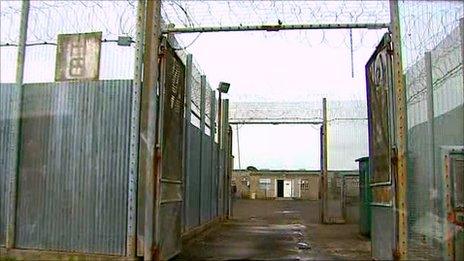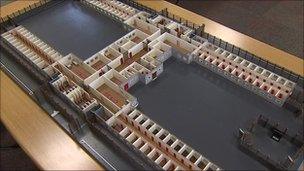Inside the Maze prison - the first public tours
- Published

The entrance to H-6 inside the former maximum security prison
To some people it's the Maze, to others it is Long Kesh. Either way it is one of the most significant buildings associated with the Troubles in Northern Ireland.
For the first time ever it was opened up to members of the public for a tour of what is left of the Maze as part of a heritage project.
The BBC were given exclusive access to take part in the tour and as the first group of the day begin to arrive at the welcome centre, they, like I, had no idea what to expect.
In its original inception the site we stood on had been RAF base Long Kesh, after the war a motor cycling racing track and then HMP Maze.
Only one of the H-Blocks remains, alongside the prison chapel and hospital wing.
'Too personal'
I was with a mixed group with people of all ages and backgrounds and some children and our first stop on our tour was H-6, a former loyalist wing. It was the block where the founder of the Loyalist Volunteer Force (LVF) Billy Wright, was murdered in 1997.
It was an emotional experience for many of the people I spoke to including one mother of five whose husband had been interned.
As we walked along the corridors she went into the booth, picked up the public phone and closed her eyes, perhaps imagining what it was like to be on the other side of receiving such a phone call all those years ago.
As we entered the chapel it was clear that unlike most parts of the site, it had remained relatively unchanged. From the internal woodwork to the rows of seats and piano in the corner.

The chapel remains largely unchanged
This was supposed to be a happier place where people sought solace and turned to their faith - from a more cynical perspective it was also an opportunity to mix with other inmates and pass notes.
But it was also a reminder for how life outside the prison went on. Over the years several marriages and baptisms took place, briefly reuniting prisoners with their loved ones.
We were told about the 20 minutes of 'private time' granted to couples in a small room by the entrance after such occasions.
As we made our way from the chapel to the hospital block we walked along a tree-lined path with dilapidated flower beds.
'Political status'
They had been built and maintained by prisoners. As we reached the end a flower bed on the right was pointed out - it had been tended to by one of the 'Shankill Butchers', a loyalist murder gang.
The tour guides offer insights into daily life in the prison and tread a fine line between facts and interpretations of events from the unionist and nationalist perspective.
One of the most poignant moments of our tour was when entering the hospital wing.
As well as housing an x-ray machine, a dentist, a not-so-padded cell and basic equipment, it is mostly known due to the 1981 Hunger Strike.
It was a seminal period in the history of the troubles, when 10 IRA prisoners died after refusing food.
It was the culmination of a longer campaign over prison conditions and political status, the first man to die was 27-year-old Bobby Sands, the leader of the Provisional IRA in the maze.

A model of the H-blocks
From prison he had been elected MP for Fermanagh/South Tyrone only weeks before his death, sparking widespread rioting and disorder in nationalist areas across Northern Ireland.
We walked along the eerily quiet corridor and made our way to cell eight. It was where Bobby Sands spent his final days.
Some people crossed the threshold and took a moment; others didn't feel comfortable going inside.
One woman told me she felt it was "too personal and too private".
As the guide took us further along the block we saw the cell where Patsy O'Hara had died. The 23-year-old former leader of the Irish National Liberation Army prisoners in the H-Blocks.
His brother had been on this tour the day before.
At the heart of the tour was a sense of just how depressing it must have been for anyone involved. Whether it be the prisoners, their families or the prison officers.
'Contentious'
It was a dangerous and frightening place with heightened tensions that threatened to spill over at any point.
In 1983 a prison meal lorry was hijacked and 38 republican prisoners escaped. It was the largest breakout from a British prison.
During the breakout four prison officers were stabbed, including James Ferris, who died of a heart attack, six others suffered gun shot wounds or stabbings. Within days, 19 prisoners were recaptured.
As we continued the tour we were led through the more recent history of the site.
As politically stability and ceasefires increased, the demise of HM Prison Maze was written into the heart of the Good Friday Agreement.
By 2000 all prisoners had left, but what happened to the site has become a contentious issue.
For years unionists and nationalists have disagreed over what should become of the controversial complex.
In 2006 it was announced that the site would be redeveloped into a multi-purpose sports stadia but these plans were shelved.
Today the man in charge of the site, Kyle Alexander, said the focus is on conflict resolution.

Michael Wiscombe was one of the people on the tour
"There is now the opportunity to do something which would be transformational here and my brief from ministers is to maximise both the economic and the reconciliation potential of the site.
"If you come here in two to three years time you would first come to what we plan to be a centre for conflict resolution where we will be able to share our experiences of peace building with the world."
Michael Wiscombe, a student finishing his masters degree on the prison was one of those taking the tour.
"I think a conflict resolution centre is a good idea but not necessarily using the original prison fabric because there is the potential for groups to see the site as a shrine - whether intentional or not it happens," he said.
And that is what is so pivotal in the success of its future incarnation.
The woman whose husband had been here said part of her wanted it to be ripped down and demolished but that the other part of her thought it should serve as a reminder of the past.
Eleven years after it closed it is this divide, even within people themselves, that means whatever happens next needs to be considered and handled with sensitivity.
- Published8 June 2011
- Published14 September 2010
- Published5 May 2011